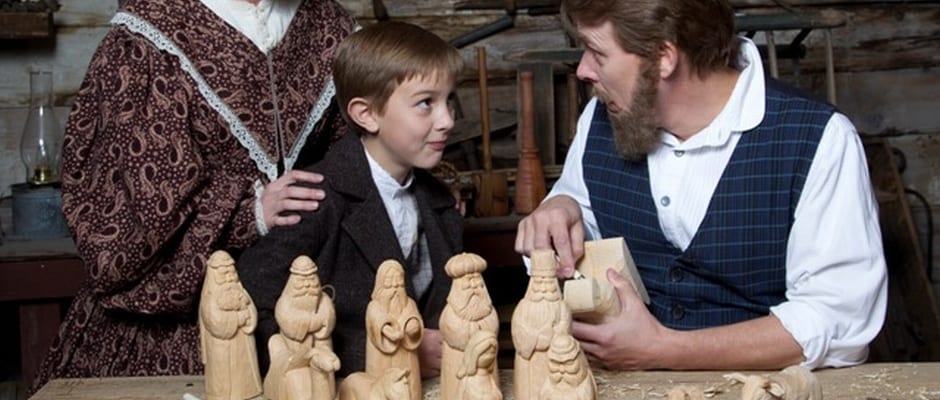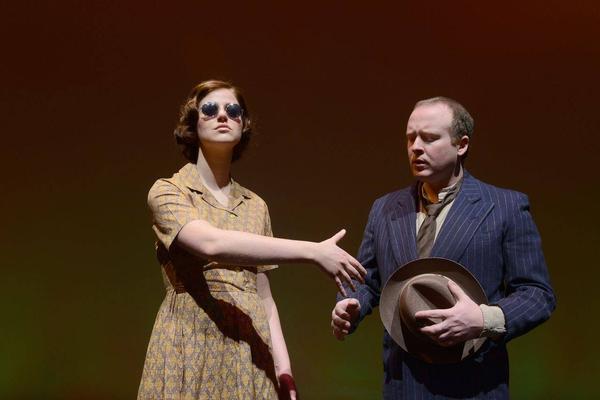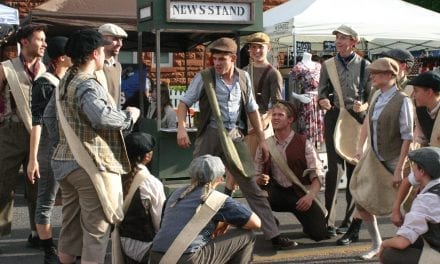OREM — Now that Thanksgiving has passed, the season for Christmas plays and musicals is upon us. I did a little digging and found that you can go see A Christmas Carol at several venues of the professional and community theater variety and I know of at least one high school that is also producing it. That’s a lot of Dickens, and of course, we all love ol’ Scrooge and his miserly ways. However, there are other options for patrons to see that spread the Christmas message.
The world premiere of The Christmas Miracle of Jonathon Toomey at Orem’s Scera theater is a Christmas entertainment option this year. I admit, this may be the first world premiere of a musical I’ve ever been to. I was pretty overwhelmed at the idea of seeing something that has never been seen before. How do I compare it or give it a good review when it’s basically brand new? So I found tonight’s offering somewhat of a challenge. I’m part of one of the first audiences to ever see this show. Wow.
The show is adapted from the picture book of the same title by Susan Wojchiechowski, published in 1995. Though I’d never heard of the book before, it has become something of a Christmas classic. Upon doing a little research, I found out that this book was first published in England and was made into a film in Britain in 2007 and did rather well at a few film festivals.
Which is why I’m somewhat baffled at some of the stylistic choices for this newest offering of Jonathon Toomey. According to the program, the show takes place in Hawkinsville, Ohio. To me, it seems like the setting for this show is somewhere along the prairie, and indeed, I was somewhat reminded of Little House on the Prairie. And the music was advertised as bluegrass and country, which would further the idea that this story takes place in the wide, wild prairie. That’s a long way from England.
But I’m getting a little off track. I want to say here that the bluegrass/country band is the very best thing this show offers. These players are brilliant, and I loved their ensemble feel. Music is played during almost the entire show and I did not catch a single bad note. On banjo and cello was Jordan Benson, Anneli Givens on fiddle, Stephen Miller on bass, Talmage Spackman on guitar and vocals, Randall Wright on guitar. (The latter also was one of the composers and playwrights). Ashley Ward’s fiddle playing and vocals were the very best in the show. She has a wistful twang in her voice that made me get a little lump-in-my-throat-ish.
As I said, the show was written by Randall Wright, along with Ward Wright and Marvin Payne. Payne also co-wrote the music with Randall Wright. The show moved as well as it could, but I had a problem with the simple story. You might think this would make for a charming play, and it would—if this was a junior high or high school offering. But for a professional theater, it was too uncomplicated. In the story, a woodcarver, Jonathan Toomey (David Morgan) loses his wife and baby to—what? Something, which in this play is a bunch of people running around the little family, around and around. Does this mean there was a hurricane? I realize it doesn’t particularly matter, but it was the beginning of my confusion in the early scenes of the show. The woodcarver turns away from his woodcarving profession, becomes merely a carpenter and moves to a new town so he can lock away the pain of losing his family. I see this as an understandable and workable plan.
The Widow McDowell, played by Annadee Morgan, along with her son Thomas, played by Caiden Kehrer, move into town. We never know how her husband died, and again, I’m not sure if this is important, but it bothered me that it wasn’t revealed. Why can’t we know? The story isn’t so filled with twists and turns that we couldn’t just know he got shot or had a heart attack or fell off a horse. The big crisis in the McDowells’ lives is that they have lost (the audience doesn’t learn how or under what circumstances) the crèche they had when the husband/father was alive. I’m not sure of the significance of the créche, but it is the source of a great deal of heartbreak for the McDowells. As I discussed the play after with my husband who accompanied me, I asked him if the father had created this crèche and my husband didn’t know. Again, why can’t the audience be told this information? Or if we were, why couldn’t it have been highlighted better? The entire rest of the play hinges on getting a new crèche, so I would have liked to know what the history of the original one was, and what happened to it. Did it burn in the fire that killed the husband? It unsettles me that this was never identified.
The widow and her remarkably outspoken, and oft-speaking son approach Toomey, as they’ve heard that he used to be a woodcarver. (How? The audience is never told. If he had left his old life behind, how did anyone in the new town know he had any talent for this?) As you can probably guess, this pair convinces Toomey that carving a new crèche is a good idea. Though Toomey is reluctant, and does several convincing door slams to let this mother and son team know that they will have to wait for the set to be done, he relents and begins carving the crèche. Soon Toomey begins to feel some life coming back to him as he carves.
Though this doesn’t seem like much of a spoiler alert as the ending of the show has to be completely obvious, the two widowed people, who just happen to be attractive (and are married in real life, which could account for the obvious and delightful chemistry between them) do end up liking each other, though there’s no big fall in love and kiss at the end of the show.
Kehrer’s portrayal of Thomas is pretty good. It’s a rather fun part to play, I’d imagine. The kid won’t take no for an answer, and even after coercing Toomey to make the crèche, Thomas tells the woodcarver what he keeps doing wrong. Kehrer is a plucky young man and brings a fun, spunky aspect to the role.
By far, the most touching moment in the show is when Toomey is faced with carving the Mother Mary and Baby Jesus. He has successfully carved all the other characters, but once he begins carving Mary and Jesus, he falls apart and I found myself willing my eyes to not tear up. David Morgan sings even while he’s crying, or at least it seemed like he was crying, and his agony seemed very real. Both he and Annadee Morgan are fine actors. Both Morgans were so finely tuned, I found them completely believable. It was a pleasure to watch them perform and I look forward to seeing them in future shows.
There are other characters in the story, but they are incidental. They make up the townspeople and are basically there to flesh out the story a bit. I think this is where I found the weakest part of the play. If there had been more depth in the subplots, I would have found the show more exciting. There was a somewhat funny bit where the town’s two eligible bachelors were presented to the widow. The trapper who’d been gone for a month in the woods clearly needed a bath, and the other bachelor, the ancient Mr. Fickewirth (Jonathan Inman), were the only two offered to this attractive, young-ish woman. I would have liked to have seen a few more wholly unlikely men brought out for her perusal.
There were some delightful ensemble dances that got the energy going. Choreographer Andrea Gunoe’s choreography was delightful—from the Virginia Reel type dances to a beautiful and tender ballet number. Costume Designer Alanna Kruger’s costumes were dazzling, though my husband felt they were all a little too similar to one another. I’m a sucker for hoop skirts and bonnets, so I thought all the women looked awesome. The men looked good, too, though they all looked a little too pristine for life on the prairie.
The set had an interesting design. It was on an angle (called a raked stage), so the audience can see the whole stage. I’m not sure why this was essential for this particular show, but it was neat to see it done. I asked a friend if it was hard to move on, as he’s performed on this type of stage, and he said it actually wasn’t that difficult. But I did wonder as the actors were dancing in the ensemble numbers if it was tiring (more tiring than most dance numbers, that is) to be going up and down on that angle
There were basically two moving sets that were pushed into the middle of the stage. On the right was Toomey’s house/workshop, and on the left, the McDowell’s kitchen. The set movement was flawless and I frankly loved seeing how effortlessly the scenes moved one after the other. Nobody clunked any set pieces or bumped into one another. The background was a little sparse, basically a few pieces of wood that constructed a frame and then just lighting the back. My son, who also accompanied me, said he liked the simple background, but because the show seemed to have a limited palette of colors, I’d have liked to have seen some kind of painted backdrop.
As my family and I discussed what we liked about the show as we drove home, we realized that there wasn’t one sound glitch in the entire show. I’ve seen shows from junior high to high school to community to professional and rarely do you go to a show that doesn’t have some annoying sound/tech issues. Hooray for the SCERA! No sound problems!
The singing in the show was passable, but not stellar. This is somewhat unfortunate, as this is a musical with a lot of songs. It was almost operatic, as there was far less dialogue than there was singing. The music itself is technically bluegrass, but I was hoping for far more of the upbeat, pickin’, stompin’ type of bluegrass. Most of the music in this show is lovely, but somewhat uninspiring. For this reason, as well as the rather slow pace of the show, I wouldn’t recommend this show for children under the age of maybe eleven or twelve. There isn’t enough going on to keep their interest and attention.
As I said in the beginning of this review, there are other offerings besides Dickens for Christmas theater. Last year, I went to Plaid Tidings at the SCERA and loved it. The Miracle of Jonathan Toomey, however, though it was about carving a crèche, reminded me a little too much of the kind of thing one sees around Pioneer Day. It seemed a little too heavy on the prairie theme and a little too light on the Christmas theme. For instance, for a very few songs, the band played traditional Christmas carols with a Bluegrass beat. I would have loved it if every single one of the songs had been like this. For me, it isn’t Christmas and it isn’t a Christmas play if I don’t hear numerous songs that I know and love and can hum along with.
I liked this show, but wanted to adore it, and wonder if it was brought to production too soon. My husband suggested that since I haven’t read the book (none of my family has), maybe I didn’t “get” the show. I disagree, simply because one shouldn’t have to read the book that inspired the play to get the play. However, since the book is a picture book, it may be that there needed to be more put into the play that just plain wasn’t in the book.
I am giving this show one thumb up and one down. There isn’t anything technically wrong with the show, and there is much that is very right. But it is slow and it isn’t for young kids. So, if you’re hoping to take your kids to a big show this Christmas as a fun outing, and you have several younger kids, I’d hit the Muppet movie in the SCERA’s movie theater and let older kids and adults see the SCERA’s musical.






